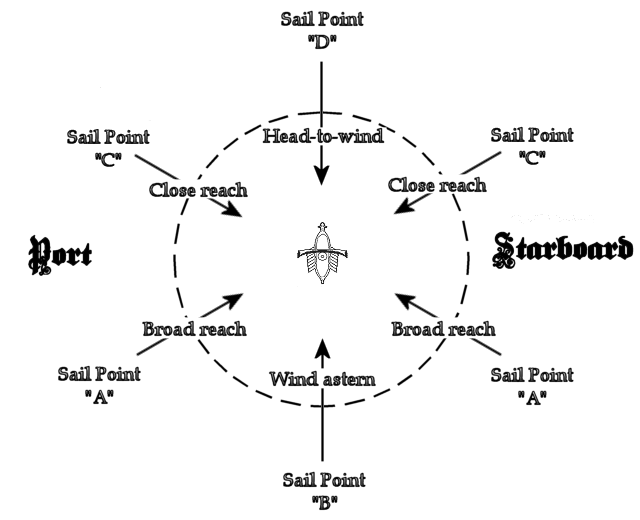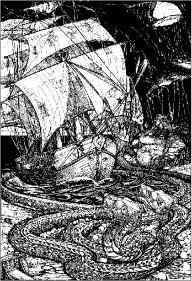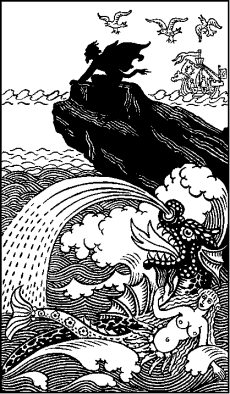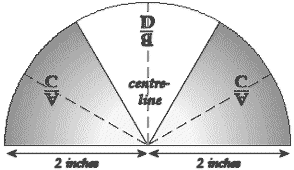

Man O' War is a fantasy battle game of naval conflict. Like many Games Workshop games it is glossy and simplistic, with many rules added on in expensive supplements and with a great many daft background elements, unfeasible even for high fantasy. Also, like many of GW's better efforts, this game is out of print- though it does make a fair few appearances on ebay.
But don't be put off, MoW is a good laugh, probably a bit simplistic for us, but its fast paced and fun with room for tactical play (tactical hint: get yourself a Wizard Lord, as magic is vastly overpowered... you don't even need a figure for it!).
Simplistic you say? Kiddies market? Surely you frothers can't allow this to continue?!
Well of course, we were tempted to leave well alone, keep a simple game simple etc etc... no lets face it we had to beef it up a bit. The element of the game that suffers most for its simplicity is the sailing rules, so without further ado the Doc completed this strap-on to make Man O War more substantial.
These rules should give a more rounded feel to the basic Man-O-War rules, as regards sailing vessels -hopefully without being over-complicated.

In the Advanced Sailing Rules there are 8 wind directions - the 4 main compass points (as in the basic game) and the four points directly between these (Northeast, Southeast, Southwest and Northwest).
In a two-player game, with ships coming in from the East and West table edges, determine initial wind direction as normal. If there are more than two players, or two navies are moving from adjacent table edges, determine wind direction as follows-
Wind direction in a two fleet battle changes whenever two players roll a tie for initiative. In an action with more than two navies you will need to choose two commanders whose initiative rolls will be counted for this purpose (otherwise the wind becomes more erratic with each additional navy present!). Whenever the two players roll a tie for initiative, the wind direction moves as determined by the value they tied on as follows-
| Value rolled | Direction Change |
| 1 | 1 point clockwise |
| 2 | 1 point anti-clockwise |
| 3 | 2 points clockwise |
| 4 | 2 points anti-clockwise |
| 5 | 3 points clockwise |
| 6 | 3 points anti-clockwise |
If a tie is rolled again the wind direction will keep moving (or perhaps move back). This will mean that on average the changes in direction will be the same, but with the potential to be more or less dramatic depending on the value rolled.
Sail movement is still determined by the wind direction relative to the ship, but this is now divided into 6 sectors or Sail Points. The four relative wind directions in the basic game are replaced by the following six: Wind Astern (Running), Head-to-wind, Close-reach (port and starboard) and Broad-reach (port and starboard). It should be noted that contrary to popular opinion (and the basic rules), sailing with the wind full astern is not the best attitude for sailing and will not gain the greatest speed from the sails.

Determine the aspect of the ship using the Sail Point Compass, placing it in at the bow or stern of the vessel (whichever is closest to the wind) with the centre aligned with the hull. The wind will pass through one of the sectors marked on the Sail Point Compass, giving you the ships position relative to the wind.

Having established the direction of the wind relative to the vessel, it is time to calculate the movement of the ship. The maximum movement remains the same, as presented on the ship template. However, in the Advanced Sailing Rules this best speed is only available to vessels sailing at Close-reach (aspect "A", to either the port or starboard). The movement rate listed for movement with "wind abeam" is now applied to vessels that are Running from the wind (Wind astern, or aspect "B").
Ships that are sailing closer to the wind (Broad-reach, or Sail Point "C", to either port or starboard) now have a movement equal to one third their top speed. A vessel stuck Head-to-wind (Sail Point "D") is In Irons, and has no sail movement or steerage just as in the basic game (but see Drifting and Tacking below).
Elf and Brettonian ships that would normally have a full move whether the wind came from the side or rear treat sail points "A" and "B" as Broad reach (sail point "B"). Refer to the The Sail Movement Table for a summary of sail movement with the Advanced Sailing Rules.
If the result is a 5, the crew has managed to trim the sails and steer the ship back to a "close-hauled" point of sail (just at the closest edge of Sail Point "C"). Place the Sail Point Compass at the stern of the vessel, this time with the centre aligned to the current wind direction. Now turn the ship so that it is pointed along the closest line of the Close Reach sailing point (this may be back in the original direction of travel- a 'feint tack'). Continue the move as normal.
If the result is a 6, the crew has successfully tacked through the eye of the wind. Place the Sail Point Compass as above, but this time the ship turns to point along either line of the Close Reach before continuing the move. In either case the ship a completed tack (or a feint tack) uses two inches of movement- vessels that recover from being In Irons at the beginning of a turn sail at Close Reach, minus the two inches required to recover. If you turn into the wind with fewer than two inches of movement remaining then your vessel automatically ends In Irons.
Sailing vessels rarely sit at rest unless docked, anchored or run aground. Even in a calm sea with no wind ships are likely to encounter drift- and Man O War does not make any allowance for a calm sea.
At the end of any sail move where a ship uses less than half of the movement available to it that turn, including vessels In Irons that cannot move, roll two six-sided dice. The lower of these is taken as the vessels drift, and the ship is immediately moved this distance in the direction of the wind.
When drifting becomes an issue, particularly close to rocks or other hazards, it becomes important to consider dropping anchor. A ship may drop anchor at the end of any turn of movement. Place an anchor counter next to the vessel to indicate its status as anchored.
Anchored ships do not drift, may fire at any valid target in their turn, and turn up to 90º in their turn. You may raise anchor at the end of any turn of movement by removing the counter.


| Sail Point | Description | Movement |
| A | Broad reach | Full movement as listed for "wind behind" in basic game. |
| B | Wind astern (or Running) | Two thirds of the Broad Reach movement, or the Movement listed in the basic game for "wind abeam" if higher. |
| C | Close reach | One third of the Broad Reach movement. |
| D | Head-to-wind | No sail movement- move ends (but see Drifting and Tacking). |

Instead of allowing Elves and Brettonian ships to move at full speed whenever the wind is to their rear (Sail Points "A" and "B") you may with the agreement of all players use these optional rules to simulate their advanced seamanship.
All sail vessels now move as described in the Advanced Sailing Rules. Brettonian vessels, for example, will move at 9" when they sail at Broad reach, at 6" with the Wind astern and at only 3" with the wind at Close reach.
Any vessels from one of these races may now add 1 to their dice roll when attempting to tack through the eye of the wind, and may re-roll any 1 dice rolled when drifting.